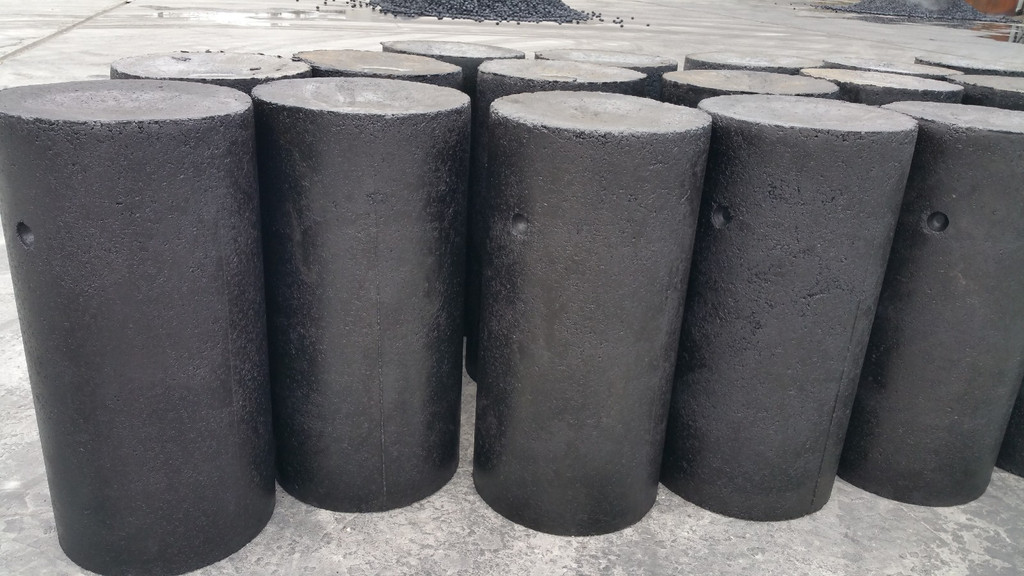Was ist Elektrodenpaste?
Elektrodenpaste ist definiert als ein leitfähiges Verbrauchsmaterial, das bei der Herstellung von Kalziumkarbid, Ferrolegierungen und gelbem Phosphor im Unterpulverlichtbogenofen verwendet wird.
Inhaltsübersicht
Umschalten aufDie Elektrodenpaste wird für die Wärmequelle eines Elektroofens verwendet, um eine selbstbackende Elektrode zu bilden. Die selbstbackende Elektrode ist eine Metallschale, die mit Elektrodenpaste gefüllt ist. Wenn der Ofen heiß ist und der Strom durch die Elektrode fließt, wird Wärme erzeugt, und die Elektrodenpaste wird zu einer leitfähigen Elektrode gebacken.
Im Allgemeinen verwenden die Hersteller während des Produktionsprozesses Rohstoffe wie: Anthrazit, Hüttenkoks, Pechkoks, Graphit und Zusatzstoffe.
Eigenschaften:
Elektrische Leitfähigkeit: Sie fördert die effiziente Übertragung von elektrischer Energie, um hohe Temperaturen zum Schmelzen von Metallschrott zu erzeugen.
Thermische Stabilität: Die Fähigkeit, extremen Temperaturen (bis zu 3000 °C) im Elektrolyseofen ohne Beeinträchtigung standzuhalten.
Mechanische Festigkeit: Die Elektrodenpaste verleiht der Elektrode strukturelle Integrität und sorgt dafür, dass sie mechanischen Belastungen und Vibrationen während des Betriebs standhält.
Verwendung von Elektrodenpaste beim Schmelzen:
Selbstbackende Elektrodenpaste wird als Hauptrohstoff zum Einbrennen von Elektroden verwendet. Im getauchten Lichtbogen OfenDie Qualität der Elektrode wirkt sich direkt auf die Produktherstellung aus. Elektroden haben die Aufgabe, Strom zu leiten und in Elektroöfen elektrische Energie in Wärmeenergie umzuwandeln.
In der industriellen Produktion wird der Strom über Elektroden in den Ofen geleitet, um Lichtbögen zu erzeugen. Die Energie des Lichtbogens wird hauptsächlich zur Freisetzung von Wärme und zur Herstellung von Produkten durch Schmelzen bei hohen Temperaturen verwendet.
Vorteile der Verwendung von Elektrodenpaste in Elektroöfen
Hohe Temperaturbeständigkeit: Die Elektrodenpaste funktioniert stabil in der Hochtemperaturumgebung von Ferrolegierungs- und Kalziumkarbidöfen.
Geringer Wärmeausdehnungskoeffizient: Er kann auch bei Temperaturschwankungen im Ofen seine Formstabilität beibehalten.
Hohe Oxidationsbeständigkeit: Da die Elektrodenpaste eine geringe Porosität aufweist, oxidiert sie bei hohen Temperaturen nur langsam, was die Lebensdauer der Elektrode verlängert.
Niedrige Kosten: Die Rohstoffe und das Herstellungsverfahren sind relativ einfach, wodurch der Preis der Elektrodenpaste viel niedriger ist als der anderer Kohlenstoffmaterialien. (z. B. Kohlenstoffelektrode).
Schlussfolgerung:
Mit der Entwicklung der Ferrolegierungs- und Kalziumkarbidindustrie steigt auch die Nachfrage nach Elektrodenpastenprodukten. Als wichtiger Rohstoff für die Herstellung von Elektroöfen bestimmen ihre mechanische Festigkeit und hohe Temperaturbeständigkeit die hohe Effizienz der Produktion.

